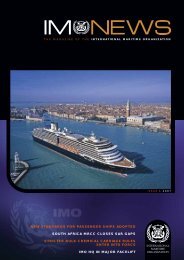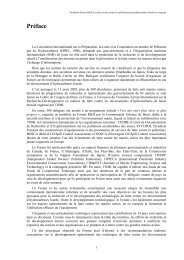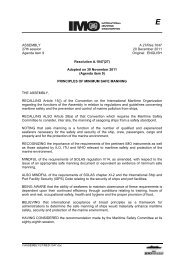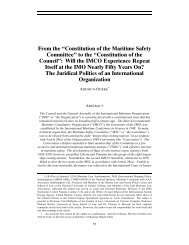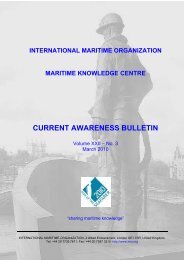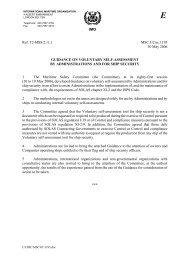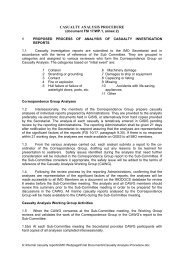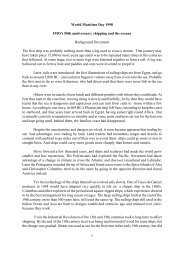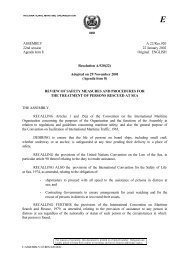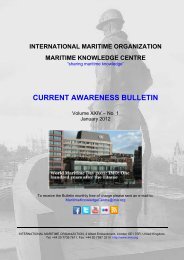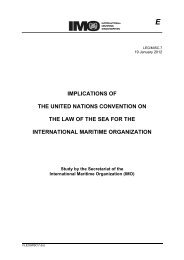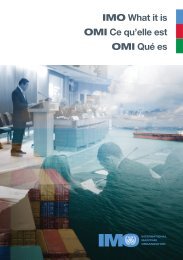Supplement: FSS Code - IMO
Supplement: FSS Code - IMO
Supplement: FSS Code - IMO
You also want an ePaper? Increase the reach of your titles
YUMPU automatically turns print PDFs into web optimized ePapers that Google loves.
.3 three-way valves: if the system is interconnected to a fixed-gas<br />
fire-extinguishing system, three-way valves are used to normally<br />
align the sampling pipes to the control panel and, if a fire is<br />
detected, the three-way valves are re-aligned to connect the<br />
sampling pipes to the fire-extinguishing system discharge manifold<br />
and isolate the control panel; and<br />
.4 control panel: the main element of the system which provides<br />
continuous monitoring of the protected spaces for indication of<br />
smoke. It typically may include a viewing chamber or smoke<br />
sensing units. Extracted air from the protected spaces is drawn<br />
through the smoke accumulators and sampling pipes to the<br />
viewing chamber, and then to the smoke sensing chamber where<br />
the airstream is monitored by electrical smoke detectors. If smoke<br />
is sensed, the repeater panel (normally on the bridge)<br />
automatically sounds an alarm (not localized). The crew can then<br />
determine, at the smoke sensing unit, which cargo hold is on fire<br />
and operate the pertinent three-way valve for discharge of the<br />
extinguishing agent.<br />
2.1.2 Any required system shall be capable of continuous operation at all times<br />
except that systems operating on a sequential scanning principle may be accepted,<br />
provided that the interval between scanning the same position twice gives a<br />
maximum allowable interval determined as follows:<br />
The interval (I) should depend on the number of scanning points (N) and the<br />
response time of the fans (T), with a 20% allowance:<br />
I = 1.2 x T x N<br />
However, the maximum allowable interval should not exceed 120 s (Imax = 120 s).<br />
2.1.3 The system shall be designed, constructed and installed so as to prevent<br />
the leakage of any toxic or flammable substances or fire-extinguishing media into<br />
any accommodation space, service space, control station or machinery space.<br />
2.1.4 The system and equipment shall be suitably designed to withstand supply<br />
voltage variations and transients, ambient temperature changes, vibration, humidity,<br />
shock, impact and corrosion normally encountered in ships and to avoid the<br />
possibility of ignition of a flammable gas-air mixture.<br />
2.1.5 The system shall be of a type that can be tested for correct operation and<br />
restored to normal surveillance without the renewal of any component.<br />
2.1.6 An alternative power supply for the electrical equipment used in the<br />
operation of the system shall be provided.<br />
2.2 Component requirements<br />
2.2.1 The sensing unit shall be certified to operate before the smoke density<br />
within the sensing chamber exceeds 6.65% obscuration per metre.<br />
2.2.2 Duplicate sample extraction fans shall be provided. The fans shall be of<br />
sufficient capacity to operate with the normal conditions or ventilation in the<br />
protected area and the connected pipe size shall be determined with consideration<br />
of fan suction capacity and piping arrangement to satisfy the conditions of<br />
4 <strong>Supplement</strong> to the <strong>FSS</strong> <strong>Code</strong> (2007 Edition)



